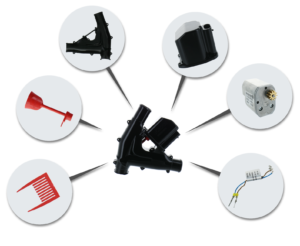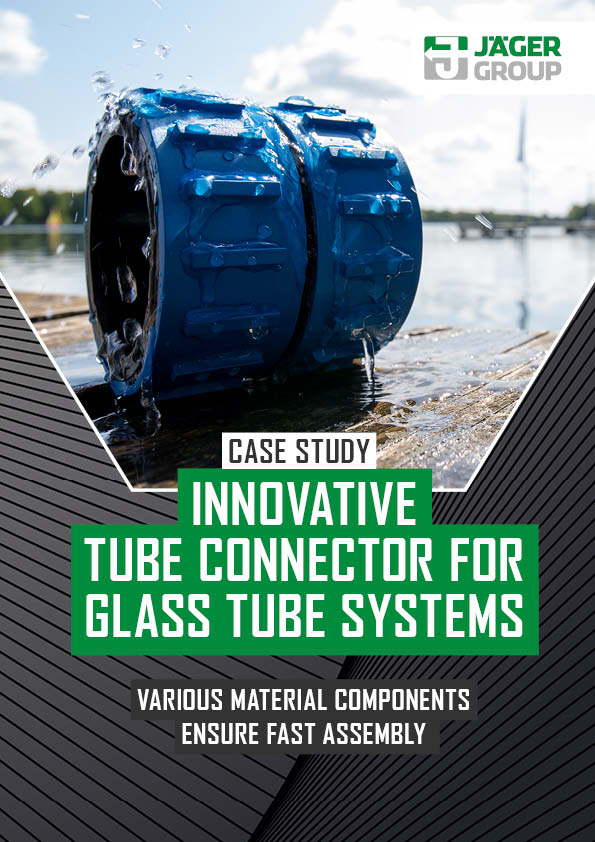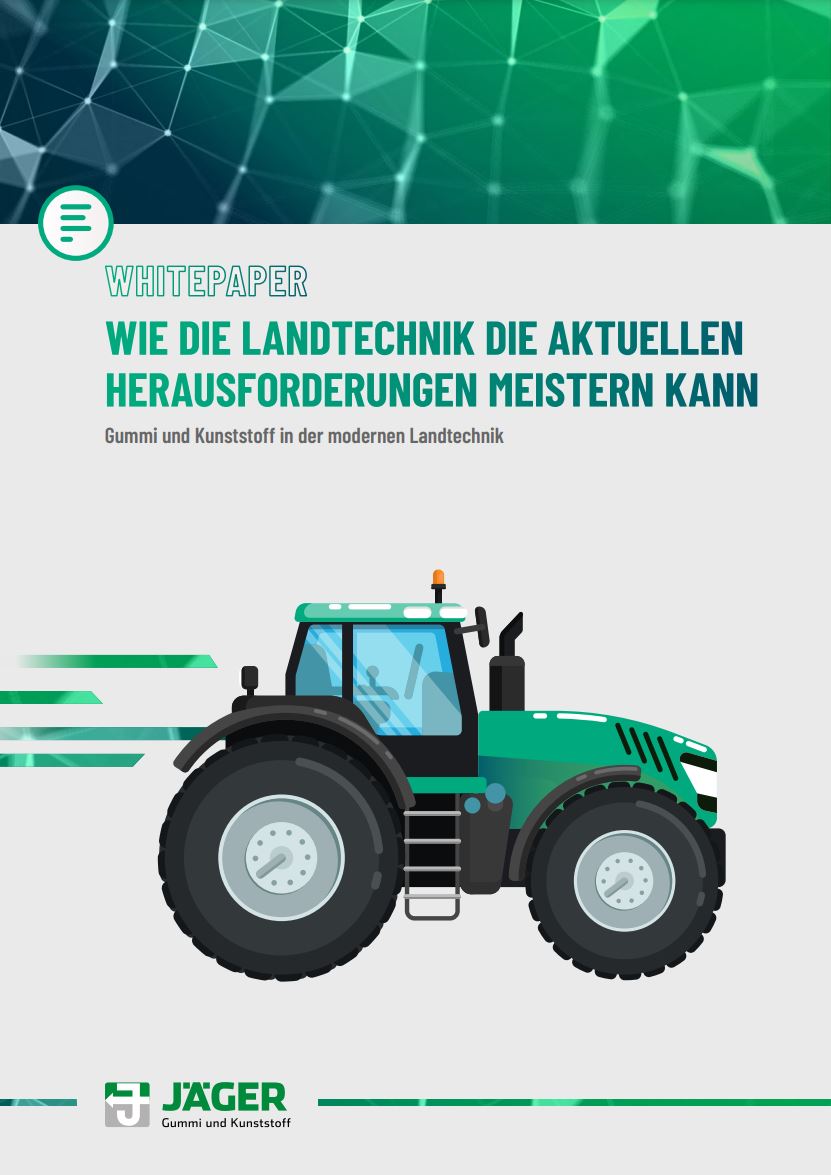
JÄGER Business Blog


WHITEPAPER
Learn how agricultural engineering can meet most of the current challenges
The ideal vertical range of manufacture has long been a point of discussion in industry. For years, the trend was to limit oneself to the own core competencies and to outsource as many work steps as possible. Although this trend has abated since Corona, it is still dominant. Production companies still tend to source individual parts from many different suppliers in order to reduce their costs. However, this approach is not always optimal. For products made of rubber and plastic, for example, it often makes sense to purchase installation-ready assemblies instead.
In the first case, the production partner manufactures all the individual parts of the assembly in-house and then takes over the installation. The prerequisite for this is that the supplier has both the know-how and the capacity to produce all the installed components itself. This in turn depends on the structure of the assembly. The more homogeneous the composition, the higher the probability of being able to obtain everything from a single source.
Jäger Gummi und Kunststoff GmbH, for example, manufactures products made of rubber and plastic. This means that we can produce all assemblies that consist of a combination of both materials (for example, a plastic housing with an annular rubber seal).
This option causes little coordination effort, as the customer obtains everything from a single source. However, it is relatively rare in practice. In most cases, assemblies consist of a heterogeneous combination of materials that no production company can (or wants to) offer on its own.
In the second case, a company purchases the assembly from an external partner. However, this partner does not manufacture all the components itself. Instead, it obtains the individual parts from other suppliers. The organization of this arrangement depends on the customer. Often, the customer turns to a production partner with a design drawing and does not make any specifications regarding the procurement of the components. In this case the partner can decide from whom it procures the individual parts.
However, it also happens that the customer specifies suppliers with whom the production partner should work. This often happens when there is already a long-standing contractual relationship that the customer wants to maintain.
In rare cases, customers also transfer the installation of an assembly to an external partner and supply this partner with components that they have produced in-house. This can make sense if only single components of the assembly are part of the customer’s core competencies. An example would be a metalworking company that purchases installation-ready hose assemblies from a partner and supplies the pressed sleeves itself.

Exploded view of an assembly
If a production partner delivers the assemblies ready for use, installation and quality inspection of the individual components are no longer required on the customer side. The customer can thus reduce its capacities or use them elsewhere and thus save costs. However, the extent to which the installation effort can actually be reduced depends on the complexity of the assembly.
From the customer’s point of view, purchasing installation-ready assemblies represents a considerable reduction in complexity. The customer no longer has to keep individual parts in stock, but only complete assemblies. The possibility of just-in-time delivery is also easier to manage when there is just a single component in the warehouse that is already produced and installed.
Coordinating several suppliers and ensuring that all components arrive on time is always a challenge for production companies. However, if the customer purchases complete assemblies ready for installation, there is only one contact person with whom he has to coordinate. This significantly reduces the coordination effort on the customer’s side, because the different suppliers do not have to be managed and maintained individually.
Installation-ready assemblies make it possible to reduce the number of components via integration. This not only has logistical advantages, but also has a positive effect on quality and costs.
It can be assumed that the producer from whom a company purchases finished assemblies is an expert in some or even all of the components or materials used. This expertise allows him to identify and work around problems regarding procurement, storage and installation at an early stage, which might be difficult for the customer.
For example, the production partner knows better which materials must be stored at certain temperatures, which must not come into contact with certain media during installation, or at what torque the screws in a material will overtighten. As a rule, the reject rate is therefore lower when assemblies are installed by a third party.
When assembling filigree components, even small deviations from the design dimensions can cause problems. In some cases, these deviations are so small that they fall below the producer’s tolerance values. If an assembly contains components from different manufacturers, it can happen that the individual parts do not fit together, even though they have passed the quality test of the respective supplier. However, if the assembly comes from a production partner who manufactures it completely in-house, the latter can precisely match the individual parts and thus avoid delays during assembly.

A company that purchases complete assemblies from a single source makes itself dependent on the manufacturer to a certain extent. Changing the supplier is relatively time-consuming, since not only the design plans of the assembly have to be passed on, but also the procurement of the individual parts. This can lead to extra work and a loss of flexibility. For this reason, a solid relationship of trust between customer and supplier based on partnership is important.
Outsourcing the production of entire assemblies to external service providers makes perfect sense from the customer’s point of view. The company can focus on its core competencies and at the same time install high-quality components. Although there is a certain dependence on the production partner, this can be compensated for by a solid relationship of trust based on partnership. The customer does not have to waive low-cost suppliers from low-wage countries either, as many suppliers are prepared to take over existing supplier relationships.
The fact that many companies are reluctant to outsource important steps in their production process is usually due to concerns about a loss of know-how. They want to keep as much knowledge as possible within the organization. These doubts are perfectly understandable, but in the long run the advantages of outsourcing usually outweigh the disadvantages.

Learn how agricultural engineering can meet most of the current challenges

Share this post!
Jäger Gummi und Kunststoff GmbH
Lohweg 1
30559 Hannover
Tel. +49 511 – 53580
Fax +49 511 – 553394
info@jaeger-gk.de
Management:
Dr.-Ing. Andreas Jäger und
Julius Jäger
Hanover Register Court HRB 59798
DE 813 314 161